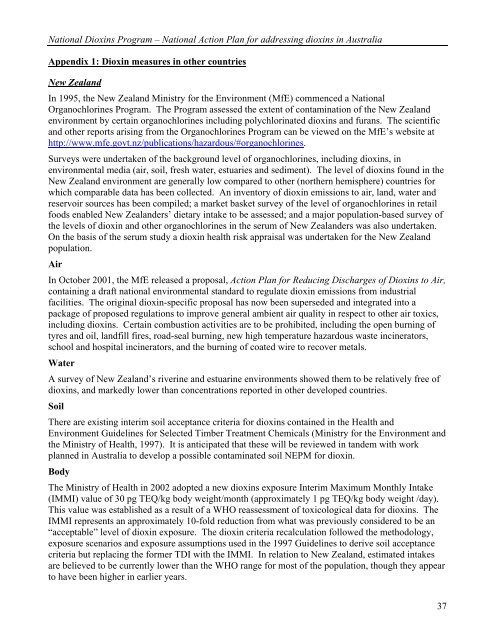National Action Plan for Addressing Dioxins in Australia
National Action Plan for Addressing Dioxins in Australia
National Action Plan for Addressing Dioxins in Australia
- No tags were found...
Create successful ePaper yourself
Turn your PDF publications into a flip-book with our unique Google optimized e-Paper software.
<strong>National</strong> <strong>Diox<strong>in</strong>s</strong> Program – <strong>National</strong> <strong>Action</strong> <strong>Plan</strong> <strong>for</strong> address<strong>in</strong>g diox<strong>in</strong>s <strong>in</strong> <strong>Australia</strong>Appendix 1: Diox<strong>in</strong> measures <strong>in</strong> other countriesNew ZealandIn 1995, the New Zealand M<strong>in</strong>istry <strong>for</strong> the Environment (MfE) commenced a <strong>National</strong>Organochlor<strong>in</strong>es Program. The Program assessed the extent of contam<strong>in</strong>ation of the New Zealandenvironment by certa<strong>in</strong> organochlor<strong>in</strong>es <strong>in</strong>clud<strong>in</strong>g polychlor<strong>in</strong>ated diox<strong>in</strong>s and furans. The scientificand other reports aris<strong>in</strong>g from the Organochlor<strong>in</strong>es Program can be viewed on the MfE’s website athttp://www.mfe.govt.nz/publications/hazardous/#organochlor<strong>in</strong>es.Surveys were undertaken of the background level of organochlor<strong>in</strong>es, <strong>in</strong>clud<strong>in</strong>g diox<strong>in</strong>s, <strong>in</strong>environmental media (air, soil, fresh water, estuaries and sediment). The level of diox<strong>in</strong>s found <strong>in</strong> theNew Zealand environment are generally low compared to other (northern hemisphere) countries <strong>for</strong>which comparable data has been collected. An <strong>in</strong>ventory of diox<strong>in</strong> emissions to air, land, water andreservoir sources has been compiled; a market basket survey of the level of organochlor<strong>in</strong>es <strong>in</strong> retailfoods enabled New Zealanders’ dietary <strong>in</strong>take to be assessed; and a major population-based survey ofthe levels of diox<strong>in</strong> and other organochlor<strong>in</strong>es <strong>in</strong> the serum of New Zealanders was also undertaken.On the basis of the serum study a diox<strong>in</strong> health risk appraisal was undertaken <strong>for</strong> the New Zealandpopulation.AirIn October 2001, the MfE released a proposal, <strong>Action</strong> <strong>Plan</strong> <strong>for</strong> Reduc<strong>in</strong>g Discharges of <strong>Diox<strong>in</strong>s</strong> to Air,conta<strong>in</strong><strong>in</strong>g a draft national environmental standard to regulate diox<strong>in</strong> emissions from <strong>in</strong>dustrialfacilities. The orig<strong>in</strong>al diox<strong>in</strong>-specific proposal has now been superseded and <strong>in</strong>tegrated <strong>in</strong>to apackage of proposed regulations to improve general ambient air quality <strong>in</strong> respect to other air toxics,<strong>in</strong>clud<strong>in</strong>g diox<strong>in</strong>s. Certa<strong>in</strong> combustion activities are to be prohibited, <strong>in</strong>clud<strong>in</strong>g the open burn<strong>in</strong>g oftyres and oil, landfill fires, road-seal burn<strong>in</strong>g, new high temperature hazardous waste <strong>in</strong>c<strong>in</strong>erators,school and hospital <strong>in</strong>c<strong>in</strong>erators, and the burn<strong>in</strong>g of coated wire to recover metals.WaterA survey of New Zealand’s river<strong>in</strong>e and estuar<strong>in</strong>e environments showed them to be relatively free ofdiox<strong>in</strong>s, and markedly lower than concentrations reported <strong>in</strong> other developed countries.SoilThere are exist<strong>in</strong>g <strong>in</strong>terim soil acceptance criteria <strong>for</strong> diox<strong>in</strong>s conta<strong>in</strong>ed <strong>in</strong> the Health andEnvironment Guidel<strong>in</strong>es <strong>for</strong> Selected Timber Treatment Chemicals (M<strong>in</strong>istry <strong>for</strong> the Environment andthe M<strong>in</strong>istry of Health, 1997). It is anticipated that these will be reviewed <strong>in</strong> tandem with workplanned <strong>in</strong> <strong>Australia</strong> to develop a possible contam<strong>in</strong>ated soil NEPM <strong>for</strong> diox<strong>in</strong>.BodyThe M<strong>in</strong>istry of Health <strong>in</strong> 2002 adopted a new diox<strong>in</strong>s exposure Interim Maximum Monthly Intake(IMMI) value of 30 pg TEQ/kg body weight/month (approximately 1 pg TEQ/kg body weight /day).This value was established as a result of a WHO reassessment of toxicological data <strong>for</strong> diox<strong>in</strong>s. TheIMMI represents an approximately 10-fold reduction from what was previously considered to be an“acceptable” level of diox<strong>in</strong> exposure. The diox<strong>in</strong> criteria recalculation followed the methodology,exposure scenarios and exposure assumptions used <strong>in</strong> the 1997 Guidel<strong>in</strong>es to derive soil acceptancecriteria but replac<strong>in</strong>g the <strong>for</strong>mer TDI with the IMMI. In relation to New Zealand, estimated <strong>in</strong>takesare believed to be currently lower than the WHO range <strong>for</strong> most of the population, though they appearto have been higher <strong>in</strong> earlier years.37
















